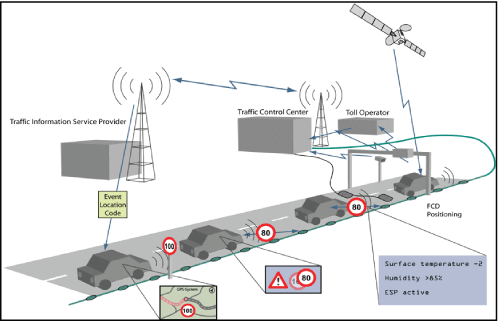by Thomas Gruber and Erwin Schoitsch
Vehicles connected via continuous wireless communication with road infrastructure on motorways, exchanging data and information relevant for the specific road segment to increase overall road safety and enable co-operative traffic management this is the vision of the Coopers project.
In the Sixth Framework Programme of the European Commission, one of the main themes deals with road traffic safety. Several projects funded by the Sixth IST Framework Programme address this topic, but Coopers takes a specific position with unique ways of achieving a safety improvement through an intelligent network which exploits existing technologies for co-operative services.
Some 38 partners from 15 European countries with industry, university and research institution backgrounds formed a consortium under the leadership of Austria Tech, a company founded by the Austrian Ministry for Transport, Innovation and Technology for driving technological development. The kick-off meeting took place in early spring 2006 and since then the innovative work has been driven by the partners in the areas of system and service architecture, safety analysis and assessment and evaluation of technologies.
Today, there exists a limited set of measures for improving road safety. Those responsible introduce legal regulations and mainly static roadside installations which warn drivers of bends, humps, narrowings and other static danger. But when it comes to accidents or traffic congestions, at present there is little guidance for the driver. Road traffic authorities and road operators rely mainly on the driver's attention, experience and capabilities. Radio traffic news is often late and inaccurate in respect of the location of the event in question. VMS (variable message signs), which could give concrete and more precise advice in case of situation-related dangers, are expensive and therefore rarely used. Currently, the high cost for VMS deployment prevents European road operators adopting this equipment for major road sections, so missing out on a huge safety gain.

Coopers is preparing the way for improving road safety on motorways at an affordable cost. Based on existing technologies and infrastructure, the driver is provided with real-time data on the current traffic situation ahead of him. Each car is equipped with a receiver for the I2V (infrastructure to vehicle) communication encapsulated in an OBU (on-board unit) and a display gives information about accidents, traffic jams, road construction sites and other location and time related events. Only messages relevant to the driver on a particular segment are passed on to him. There is no irrelevant data about traffic congestions or accidents in remote areas of the country as happens with traffic news on the radio. The information is accurate and precise both in terms of location and time.
Because the driver will be depending on the reliability and accuracy of information, I2V will strongly increase the responsibility and liability of the infrastructure operator. The most effective use of I2V communications is expected in areas of dense traffic where the accident risk and the probability of traffic jams are very high. In addition to V2I and in parallel to it, but in the reverse direction, ie by a I2V (infrastructure to vehicle) link, the real time communication can also be used for verifying infrastructure sensor data using vehicles as floating sensors.
Coopers has started with an assessment of existing technologies, of possible safety improvements and a selection of those services most appropriate for testing the new approach. The work plan comprises three steps for implementing the I2V communication:
-
improve road sensor infrastructure and traffic control applications for more accurate traffic information with a infrastructure-to-vehicle communication concept utilising a link to road tolling systems
-
develop adequate communication concepts and applications ensuring reliability, real-time capability and robustness considering different technologies like DAB or CALM.
-
demonstrate results on important European motorway sections with high traffic density (Rotterdam-Antwerp, Berlin/Darmstadt, Nuremberg-Brenner-Verona) and increase development strategies.
Coopers is compliant with the objective of sustainable transport and development defined in the EC White Paper on Transport policy. (The impact of Coopers activities is shown in the graph below). As a result it will demonstrate a prototype for future intelligent traffic management systems.
Coopers Mission
To define, develop and test new safety related services, equipment and applications using two way communication between road infrastructure and vehicles from a traffic management perspective. COOPERS will build upon existing equipment and infrastructure as far as possible to incorporate bi-directional infrastructure-vehicle links as an open standardised wireless communication technology. The role of motorway-operators in offering and retrieving safety relevant and traffic management information for specific road segments on European motorways based on infrastructure and in-vehicle data will be investigated.
Work Areas in Coopers
-
Safety related traffic management and information services
-
Roadside and vehicle based data acquisition
-
Traffic Control Centre - TCC Applications
Bi-directional I2V / V2I link -
Roadside Transmitter
-
On Board Unit extension and integration
-
Standardisation.
Please contact:
Thomas Gruber, Erwin Schoitsch, ARC Seibersdorf research, Austria
E-mail: {Thomas.Gruber, Erwin.Schoitsch}![]() arcs.ac.at
arcs.ac.at










